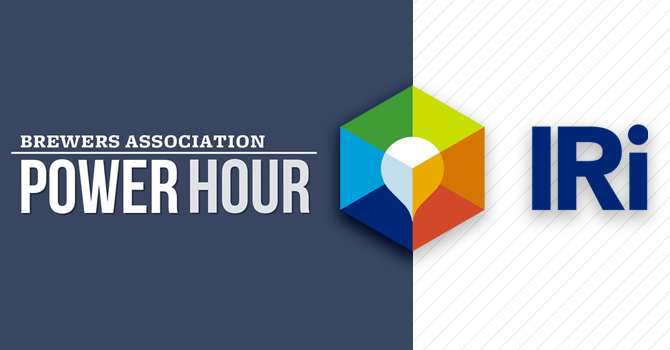
Wine and spirits brands are cutting into the growth of the craft beer segment, according to Patrick Livingston, director of client insights for market research firm IRI.
Livingston, who led yesterday’s Power Hour presentation hosted by the Brewers Association (BA), said craft beer dollar sales were up just 1.7 percent in IRI’s multi-outlet off-premise U.S. retail universe (excluding convenience stores) through July 8. Livingston added that craft has begun to plateau in off-premise channels, with volume sales leveling off since late March.
“No longer are we seeing incremental growth every single month,” he said.
Overall beer dollar sales were up 2.1 percent, a slight increase from 1.9 percent growth during the same period in 2017, Livingston said. However, the growth of wine (up 3 percent) and spirits (up 4.6 percent) are outpacing the beer category, and beer’s share of the total beverage alcohol market now sits below 50 percent (49.7 percent) in the U.S.
What’s perhaps more troubling for beer makers, however, is that IRI “confirmed” that consumers are actually shifting away from beer purchases in favor of wine and spirits.
“What is certainly alarming for a lot of the craft brewers on the call is the spirits category has accelerated dramatically in year-to-date 2018,” he said.
And while there’s “still some healthy growth” to be had for craft beer companies, Livingston said the category has gone from the third biggest growth driver within beer in 2016 (when it trailed only imports and super premiums) to ninth this year. According to IRI, craft’s tumble is due to the success of spirits — notably whiskey, vodka and tequila — as well as wine pricing tiers.
“Tequila is posting nearly as much dollar growth as the whole craft beer category, yet it’s only a fraction of the size,” he said.
Nevertheless, BA-defined craft beer dollar sales are up 2.8 percent in IRI-tracked multi-outlet and convenience stores through July 8.
But dollar sales growth within the high end of the beer segment isn’t going to be enough to offset category-wide declines, Livingston said. Although beer offerings account for more than 54 percent of the dollar share growth within the high end of all beverage alcohol, it has lost nearly a full point of share to wine and spirits.
Livingston explained that while consumers are buying more high end beer products, there are now fewer households purchasing beer overall — and those households that are buying beer have cutback on the amount of beer they purchase at a time when the number of shopping trips they make to purchase beer has also declined.
To help win back market share, Livingston stressed the importance of innovation and pointed to $33 million in sales for new brands this year.
“Without that innovation, the craft segment would be in decline,” he said. “Obviously, innovation is an extremely important part of continuing growth within the craft segment, as it is throughout the beer category.”
The top selling innovation brand of the year thus far is Anheuser-Busch InBev’s Bud Light Orange line extension, with more than $13.2 million in sales. Other top performing new brands include Michelob Ultra Pure Gold, New Belgium Voodoo Ranger Juicy Haze IPA, and Boston Beer’s Angry Orchard Rosé and Truly Spiked and Sparkling berry mixed pack.
New England-style IPAs, which were up more than 200 percent in dollar sales and 250 percent in volume through July 8, also continue to grow. New Belgium’s Voodoo Ranger Juicy Haze and Boston Beer’s Samuel Adams New England IPA were the top selling brands.
At the company level, five of the top 15 BA-defined craft suppliers are growing volume by double-digits, including Firestone Walker (up nearly 16 percent), Stone Brewing (up 10.6 percent), Oskar Blues (up nearly 20 percent), Dogfish Head (up nearly 14 percent) and Artisanal Brewing Ventures (up more than 18 percent).
Still, Livingston said it’s “feast or famine” for the top 15 BA-defined craft brands in multi-channel and convenience stores. The ones that are growing, are “growing really fast,” and those in decline doing so “very rapidly,” he said.
Among the top 15 craft brands, five are growing double digits, including Samuel Adams seasonal (up 16.4 percent), Firestone Walker 805 (up 20.5 percent), Bell’s Two Hearted Ale (up 13.7 percent), Sierra Nevada seasonal (up 21 percent) and New Belgium Rampant Imperial IPA (up 38.6 percent).
Craft beer in cans, as well as high priced ($9-11) and ultra high priced (more than $11) 6-packs, are driving the lion’s share of the growth of the craft segment, Livingston said.
Livingston called craft 15-packs “a runaway hit,” adding that they’re up 77.3 percent in grocery stores. Additionally, dollar sales of single-serve 24 oz. and 19.2 oz. craft cans are up more than than 300 percent in convenience stores, while 6-packs are up 36 percent.
Livingston also said 38 percent of all IRI-tracked craft segment sales are now coming from canned offerings (compared to 28.4 percent of premium can sales).
